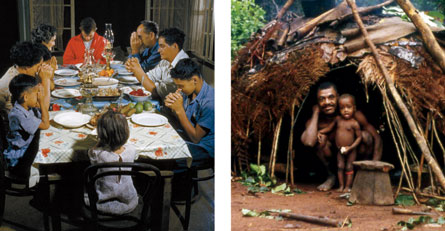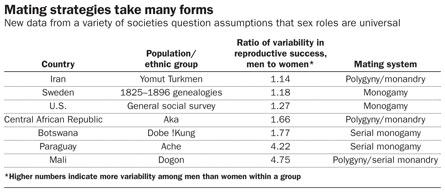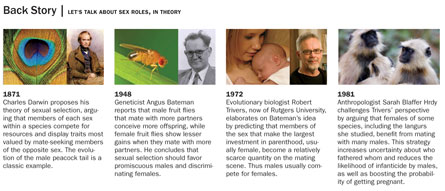Males, females swap sex-role stereotypes
Analysis finds that mating strategies are not universal

Chuck that nonsense about “men are from Mars, women are from Venus.” Here on Earth, the sexes play the mating game with a flexible set of rules. A new study suggests that scientists should abandon the idea that males evolved to be promiscuous and females to be selective.
Combined data from 18 modern and traditional societies show greater overall variation in reproductive success for men than for women — with some men producing lots of children with multiple partners and other men conceiving few or no children, say psychologist Gillian Brown of the University of St. Andrews in Fife, Scotland, and her colleagues. Women tend to have a handful of children.
In the past, researchers have treated this pattern as a sign of universal mating tendencies, with women limiting how many children they bear and men conceiving as many children as possible.
Yet the same pattern of distinctive male and female sex roles doesn’t appear when many of these same 18 societies are examined individually, Brown’s group reports in the June Trends in Ecology & Evolution. In monogamous societies and even in some polygynous ones, where men can have more than one wife or mate, men and women can have similar variation in the number of children they produce, the scientists find.
Monogamous societies in the new study included Pitcairn Islanders in the South Pacific, Dobe !Kung hunter-gatherers in southern Africa and 19th century Swedes. Polygynous societies displaying comparable or only slightly unequal patterns of reproductive success for men and women included Aka hunter-gatherers in central Africa, Hadza hunter-gatherers in southern Africa and nomadic Yomut Turkmen in Iran.
Looking at the data all together, patterns of reproductive success were skewed by data from a few polygynous societies in which small numbers of men conceived the bulk of the offspring, the researchers contend. Examples of this pattern came from the Dogon and Kipsigis, both in Africa.
“Half of the populations we studied had similar variations in male and female reproductive success, which is inconsistent with universal stereotypes of passive, discriminating females and promiscuous males,” Brown says.
These scientific generalizations originated with fruit fly studies conducted by English geneticist Angus Bateman in 1948. He reported that male flies exhibited greater variation than females in numbers of sexual partners and offspring. Females mating with several males showed less of an increase in the number of offspring than males mating with many females.
Bateman concluded that it was more costly for females to produce a single egg than for males to produce a single sperm, leading to “discriminating passivity” among female flies and “undiscriminating eagerness” among male flies.
But in the past decade or so, studies of fruit flies and other animals have documented considerable variation in numbers of sexual partners and offspring for both sexes. Situational factors shape animals’ mating decisions, Brown asserts. Investigations suggest that females often get choosy when outnumbered by males or required to raise offspring alone. Males become picky when outnumbered by females or when required to help raise offspring. In small, spread out populations with roughly equal numbers of males and females, both sexes tend to mate indiscriminately.
Brown and her colleagues provide initial evidence that the “astonishing flexibility” of mating strategies also applies to people, remarks behavioral ecologist Stephen Emlen of Cornell University.
“A lot of nonhuman animals that are thought of as innately controlled robots actually perform sophisticated cost-benefit analyses of different choices and adjust their behavior based on flexible rules of thumb,” asserts Emlen, who studies mating decisions in birds. Emlen says it would be surprising if people didn’t have even more variable mating strategies than other animals.
Anthropologist Lee Cronk of Rutgers University in New Brunswick, N.J., says that he hopes the study “will have a major impact on future evolutionary work on human mating patterns.”
Cronk still thinks that universal mating strategies exist for men and women and were genetically ingrained during the Stone Age. But these strategies can play out in a variety of ways depending on the cultural, social and demographic features of modern societies.
Brown sees the situation differently. Disparities in learned mating strategies and cultural beliefs that have developed among groups over the past 50,000 years or so have also led to genetic differences among those populations, not to universal mating tendencies, she suspects.
Brown’s group analyzed information on reproduction and mating in hunter-gatherer, farming and industrialized societies from already published studies. Although these studies depended on women’s reports of who fathered their children, Brown regards the reliability of such evidence as comparable between monogamous and polygynous societies.
Scientists must now try to estimate and compare numbers of sexual partners, as well as offspring, for individuals in different societies, she says. Doing so will be challenging, since attempts to establish the numbers of sexual partners for men and women have relied on self-reports that are unreliable, Brown asserts.
She and her colleagues remain cautious about assuming that men always have more sexual partners than women in polygynous societies. In about half of polygynous societies, most men still take no more than one wife, they note. In others, women as well as men conceive children with two or more partners.
Thorough cross-cultural studies would likely reveal a great variety of mating strategies that respond to local conditions, predicts behavioral ecologist Mhairi Gibson of the University of Bristol in England. “Unfortunately, few anthropologists continue to collect such quantitative data on human behavior,” she says.

Click on the table to view a larger version | Source: Adapted from Brown et al.

Click on the table to view a larger version | Credits left to right: Bkindler/istockphoto; Reproduced with permission from john van wyhe, ed., the complete work of Charles Darwin online (darwin-online.org.uk); Janeff/istockphoto; John Innes Archives, Courtesy of the John Innes Foundation; AJPhoto/istockphoto; Nick Romanenko/Courtesy Rutgers Univ.; Serengeti130/istockphoto







